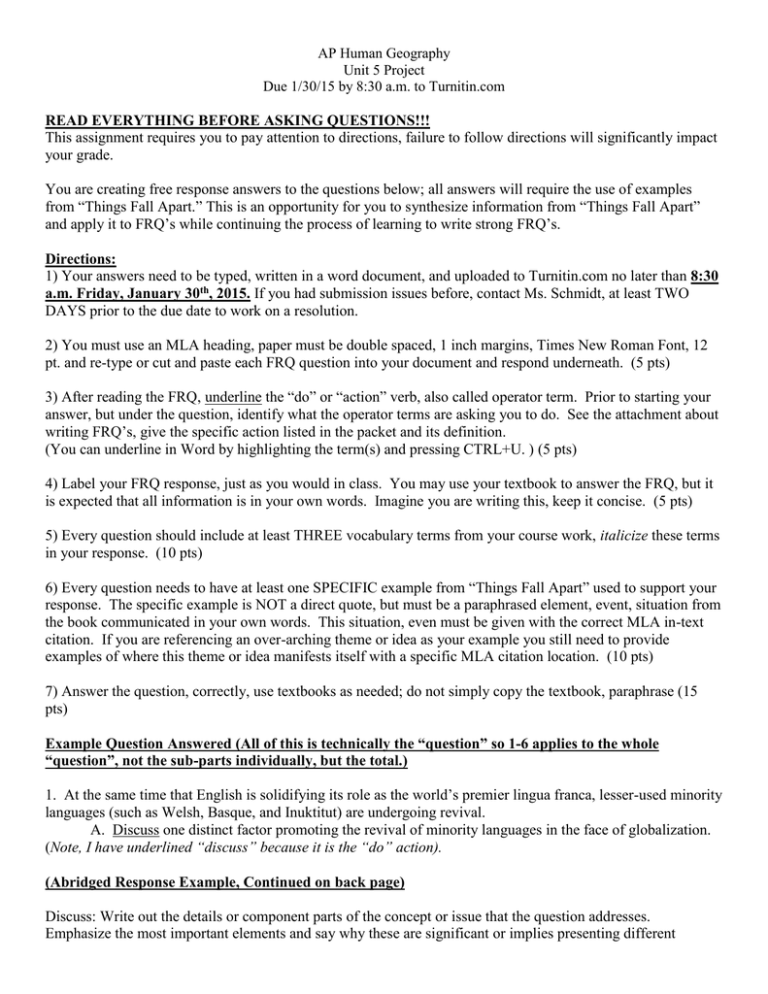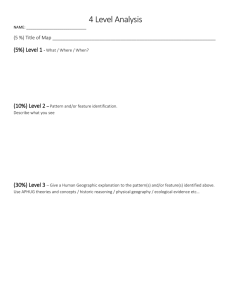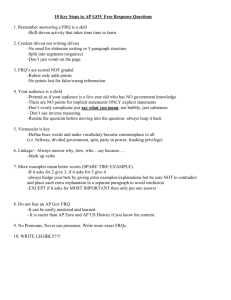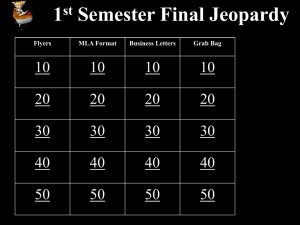AP Human Geography Unit 5 Project Due 1/30/15 by 8:30 a.m. to
advertisement

AP Human Geography Unit 5 Project Due 1/30/15 by 8:30 a.m. to Turnitin.com READ EVERYTHING BEFORE ASKING QUESTIONS!!! This assignment requires you to pay attention to directions, failure to follow directions will significantly impact your grade. You are creating free response answers to the questions below; all answers will require the use of examples from “Things Fall Apart.” This is an opportunity for you to synthesize information from “Things Fall Apart” and apply it to FRQ’s while continuing the process of learning to write strong FRQ’s. Directions: 1) Your answers need to be typed, written in a word document, and uploaded to Turnitin.com no later than 8:30 a.m. Friday, January 30th, 2015. If you had submission issues before, contact Ms. Schmidt, at least TWO DAYS prior to the due date to work on a resolution. 2) You must use an MLA heading, paper must be double spaced, 1 inch margins, Times New Roman Font, 12 pt. and re-type or cut and paste each FRQ question into your document and respond underneath. (5 pts) 3) After reading the FRQ, underline the “do” or “action” verb, also called operator term. Prior to starting your answer, but under the question, identify what the operator terms are asking you to do. See the attachment about writing FRQ’s, give the specific action listed in the packet and its definition. (You can underline in Word by highlighting the term(s) and pressing CTRL+U. ) (5 pts) 4) Label your FRQ response, just as you would in class. You may use your textbook to answer the FRQ, but it is expected that all information is in your own words. Imagine you are writing this, keep it concise. (5 pts) 5) Every question should include at least THREE vocabulary terms from your course work, italicize these terms in your response. (10 pts) 6) Every question needs to have at least one SPECIFIC example from “Things Fall Apart” used to support your response. The specific example is NOT a direct quote, but must be a paraphrased element, event, situation from the book communicated in your own words. This situation, even must be given with the correct MLA in-text citation. If you are referencing an over-arching theme or idea as your example you still need to provide examples of where this theme or idea manifests itself with a specific MLA citation location. (10 pts) 7) Answer the question, correctly, use textbooks as needed; do not simply copy the textbook, paraphrase (15 pts) Example Question Answered (All of this is technically the “question” so 1-6 applies to the whole “question”, not the sub-parts individually, but the total.) 1. At the same time that English is solidifying its role as the world’s premier lingua franca, lesser-used minority languages (such as Welsh, Basque, and Inuktitut) are undergoing revival. A. Discuss one distinct factor promoting the revival of minority languages in the face of globalization. (Note, I have underlined “discuss” because it is the “do” action). (Abridged Response Example, Continued on back page) Discuss: Write out the details or component parts of the concept or issue that the question addresses. Emphasize the most important elements and say why these are significant or implies presenting different aspects of something by examining various sides or opinions. (I have written out what the prompt is asking me to do, using the handouts attached). 1A. One factor influencing the revival of minority languages is devolution, where nations/groups are using this as a source of identity and unity to distinguish themselves from the state. However, sometimes this language is seen as a source of conflict by the power in authority and is actively sought to be suppressed. In “Things Fall Apart” unity in language is seen towards the end of the novel, when Onyeka is asked to salute Umuofia, drawing in the crowd, but in his native language (Achebe 101). (Devolution is italicized because it is one of the three needed vocabulary terms.) Questions 1) Geographers define space, location, and distance according to both absolute and relative measures. A) Describe the difference between absolute and relative measures of distance. B) Give two examples of instances where the degree of interaction between places is more related to connectivity than to absolute distance. C) Describe the difference between absolute and relative measures of location. Provide at least two examples. 2) In 1977 Abdel Omran first described the epidemiological transition model that explains health and disease patterns in populations. A) Identify and explain how the three major stages of the epidemiological transition model impact population growth, life expectance, and mortality rates at each stage. B) Identify and explain two factors (either social, environmental, or economic) that contribute to longer life expectancies at birth. 3) Ernest Rostow’s Modernization Model and the Demographic Transition Model heavily influence one another. A) Describe Rostow’s Model and the Demographic Transition Model. B) To what extent does the Demographic Transition Model influence Rostow’s Model? 4) Walls have been used throughout history with various purposes. A) Identify and explain at least two functional differentiations of walls within villages. B) Provide three real-world examples of walls used by states in the 20th century. C) Choose one wall in part B and assess the effectiveness of this wall. 5) The modern state idea dates back to the 1600’s. A) Explain the modern state idea. B) Analyze the impact the modern state has had on nations. C) Provide an example of a post-1950 modern state still impacted by colonialism.




